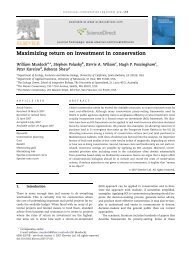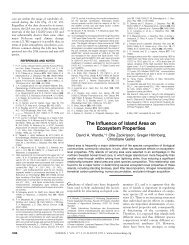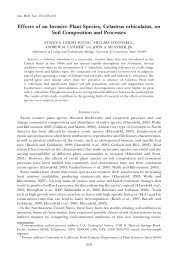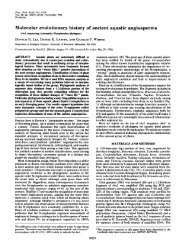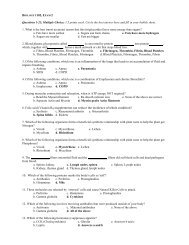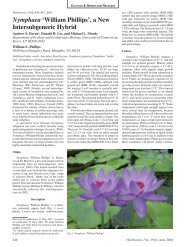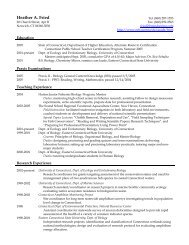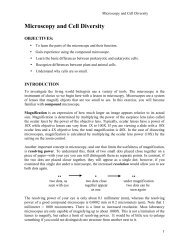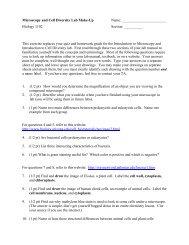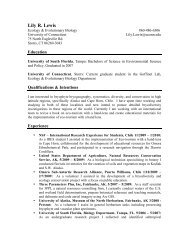Download pdf. - Ecology and Evolutionary Biology Department ...
Download pdf. - Ecology and Evolutionary Biology Department ...
Download pdf. - Ecology and Evolutionary Biology Department ...
Create successful ePaper yourself
Turn your PDF publications into a flip-book with our unique Google optimized e-Paper software.
A guide to<br />
Invasive Aquatic Plants<br />
of Connecticut<br />
Robert S. Capers, Gregory J. Bugbee, Roslyn Selsky <strong>and</strong> Jason C. White<br />
The Connecticut Agricultural Experiment Station<br />
123 Huntington Street<br />
P.O. Box 1106<br />
New Haven, Connecticut 06504<br />
Bull. No. ______<br />
January 2005
2<br />
© 2005 The Connecticut Agricultural Experiment Station<br />
Bulletin No. ___<br />
Cover photo: Eurasian water-milfoil, Myriophyllum<br />
spicatum, by Alison Fox, University of Florida
3<br />
Introduction to aquatic plants<br />
Aquatic plants are essential components of healthy ecosystems in freshwater lakes <strong>and</strong><br />
ponds, producing oxygen, reducing erosion <strong>and</strong> regulating nutrient cycling (Hutchinson, 1975).<br />
They provide food for many birds as well as habitat that supports rich communities of aquatic<br />
invertebrates <strong>and</strong> vertebrates (Sculthorpe, 1967).<br />
Invasive plants, however, are not native species, <strong>and</strong> they are often destructive<br />
(Vitousek et al., 1996). Non-native plants <strong>and</strong> animals are responsible for economic losses <strong>and</strong><br />
control costs estimated in one analysis at $137 billion per year in the United States alone<br />
(Pimentel et al. 2000). Invasive aquatic plants are noted for their explosive growth potential<br />
(Barrett, 1989) <strong>and</strong> their ability to grow from a few plants to cover hundreds of acres in a few<br />
years (Groth et al., 1996). Invasive aquatic plants have caused declines in native plant populations<br />
throughout New Engl<strong>and</strong> (Sheldon, 1994). In some water bodies, invasive plants have become<br />
so abundant that they have displaced native species (Langel<strong>and</strong>, 1996). Many biologists<br />
feel invasive species are second only to habitat destruction as the most serious threat to endangered<br />
species globally (Wilcove et al., 1998).<br />
Because of their great growth potential, invasive aquatic plants can block navigation<br />
channels, irrigation ditches <strong>and</strong> water intake pipes, <strong>and</strong> they can reduce aesthetic <strong>and</strong> recreational<br />
value of water bodies, affecting tourism <strong>and</strong> real estate values (Catling <strong>and</strong> Dobson,<br />
1985). In some cases, the plants have been found to increase breeding habitat for mosquitoes<br />
(Eiswerth et al., 2000). An estimated 76% of the invasive aquatic plants in southern New Engl<strong>and</strong><br />
were introduced as cultivated plants <strong>and</strong> later escaped (Les <strong>and</strong> Mehrhoff, 1999). It is<br />
thought that much of the subsequent spread of invasive plants from one lake to another is from<br />
recreational boating (Couch <strong>and</strong> Nelson, 1985).
4<br />
Attempts to eradicate invasive aquatic plants once they become established often have<br />
failed (Anonymous, 1993; Groth et al., 1996; Simberloff, 1997), <strong>and</strong> management is expensive<br />
(Langel<strong>and</strong>, 1997; Center et al., 1997). Early identification of invasive plant populations, thus,<br />
is critically important (Simberloff, 1997; Wittenberg & Cook, 2001).<br />
The Connecticut Agricultural Experiment Station (CAES) has begun a surveillance <strong>and</strong><br />
monitoring program to establish the geographical distribution of invasive aquatic plants in state<br />
lakes <strong>and</strong> ponds. The program will establish where invasive plants occur <strong>and</strong> track their spread<br />
in the future. In many cases, quantitative vegetation surveys have not previously been done, <strong>and</strong><br />
the absence of historic information makes it difficult to determine what changes resulted from<br />
plant invasions <strong>and</strong> what resulted from management activities (Sheldon, 1994). The CAES surveillance<br />
program will provide baseline information so the extent <strong>and</strong> nature of ecological<br />
change resulting from any future plant invasions can be determined. The surveys build on<br />
aquatic plant <strong>and</strong> bathymetric work done through the state <strong>Department</strong> of Environmental Protection’s<br />
Geologic <strong>and</strong> Natural History Surveys as well as many decades of collecting by professional<br />
<strong>and</strong> amateur botanists in the state.<br />
This guide contains information on the history, ecology <strong>and</strong> identification of nine invasive<br />
aquatic plants. Distribution maps for each species, based on herbarium records <strong>and</strong> surveys<br />
done by many biologists, are also shown. However, all of the state’s lakes have not been surveyed,<br />
so the maps likely represent incompete distributions of the plants. The nine plants discussed<br />
here are not all of the species that threaten Connecticut lakes <strong>and</strong> ponds, but they are<br />
among those with the greatest potential to cause environmental <strong>and</strong> economic damage. This<br />
guide is intended to help non-scientists identify the plants in the interest of retarding their<br />
spread in the state <strong>and</strong>, where possible, preventing their introduction.
5<br />
EURASIAN WATER-MILFOIL<br />
Myriophyllum spicatum<br />
Eurasian water-milfoil is one of the most<br />
serious threats among invasive aquatic plants in<br />
the United States (Bartodziej <strong>and</strong> Ludlow,<br />
1998). A native of Europe <strong>and</strong> Asia, the first<br />
reliable collections of Eurasian water-milfoil in<br />
the United States date from the 1940s, when it<br />
Figure 1. Distribution of Myriophyllum<br />
spicatum in Connecticut.<br />
Figure 2. Eurasian water-milfoil, Myriophyllum<br />
spicatum<br />
was reported from Washington, D.C., Arizona,<br />
California <strong>and</strong> other states, apparently as the result of independent escapes from cultivation<br />
(Les <strong>and</strong> Mehrhoff, 1999). The species was first collected in Connecticut in 1979, <strong>and</strong> it has<br />
spread quickly since then, occurring primarily in the alkaline waters of the western part of the<br />
state. Herbarium records <strong>and</strong> surveys indicate that it occurs in more than 40 ponds <strong>and</strong> lakes in<br />
Connecticut as well as in many areas on the Connecticut River (Figure 1).<br />
Eurasian water-milfoil is one of<br />
several milfoils that occur in Connecticut<br />
ponds <strong>and</strong> lakes, including several native<br />
species, so identification can be difficult.<br />
Leaves occur in whorls around the stem,<br />
usually four leaves together (Aiken et al.,<br />
1979), as shown in Figures 2 <strong>and</strong> 3. Eurasian<br />
water-milfoil leaves have a very fine,<br />
feathery appearance. Each leaf is com-
6<br />
posed of threadlike leaflets, <strong>and</strong> Eurasian watermilfoil<br />
leaves usually have more than 14 pairs of<br />
leaflets on each leaf (Moody <strong>and</strong> Les, 2002). Other<br />
milfoil species usually have fewer than 14 pairs of<br />
leaflets. Eurasian water-milfoil can be distinguished<br />
from variable-leaf milfoil, another invasive species,<br />
by the distance between the leaves on the stem. On<br />
Eurasian water-milfoil, leaves are more spread out<br />
Photo by Vic Ramey<br />
University of Florida<br />
Figure 3. Eurasian water-milfoil,<br />
Myriophyllum spicatum<br />
on the stem <strong>and</strong> are generally more than an inch apart except at the very top of the stem,<br />
whereas variable-leaf milfoil has whorls of leaves less than an inch apart all up <strong>and</strong> down the<br />
stem (Hellquist <strong>and</strong> Straub, 2002).<br />
Plants germinate early in the year, producing long stems that can reach the surface in 12<br />
feet of water or more (Reed, 1997). When it reaches the surface (Figure 4), the stems spread<br />
out <strong>and</strong> can form a thick mat of vegetation (Aiken et al., 1979). The species can produce very<br />
thick st<strong>and</strong>s of large plants (Reed, 1977), interfering with boating, swimming <strong>and</strong> other recreational<br />
activities (Reed, 1977; Bates et al., 1985), displacing native plants (Madsen et al., 1991),<br />
altering the abundance of fish populations (Keast, 1984) <strong>and</strong> depressing real estate values<br />
(Bates et al., 1985).<br />
Stems of Eurasian water-milfoil break easily, producing fragments that then can grow<br />
into new plants. In fact, the plants reproduce primarily in this way, although they also produce<br />
seed <strong>and</strong> spread over short distances with horizontal stems in the sediment (Madsen et al., 1988;<br />
Madsen et al., 1991). Propellers on boat motors are effective at producing fragments that then<br />
act as propagules, dispersing the plant to new locations (Liddle <strong>and</strong> Scorgie, 1980).
7<br />
Once established, Eurasian water-milfoil spreads aggressively, <strong>and</strong> managing it is difficult <strong>and</strong><br />
expensive (Pimentel et al., 2000; Eiswerth et. al. 2000). As a result, preventing the species from<br />
arriving is important. Once it is introduced into a region, the species can spread by boaters who<br />
carry fragments of plants on their propellers or trailers (Johnstone et al., 1985; Howard-<br />
Williams, 1993), although the species likely spreads in other ways as well (Les <strong>and</strong> Mehrhoff,<br />
1999). Any fragment can act as a propagule that could establish a new population of the species<br />
in a lake where it does not already occur.<br />
Figure 4. Eurasian water-milfoil, Myriophyllum spicatum
8<br />
VARIABLE-LEAF WATER-MILFOIL<br />
Myriophyllum heterophyllum<br />
This species is native to the southern<br />
United States <strong>and</strong> has become a nuisance in<br />
many Connecticut lakes since arriving in<br />
1936, especially in the southeast part of the<br />
state (Les <strong>and</strong> Mehrhoff, 1999). It is known<br />
to occur in at least 30 ponds <strong>and</strong> lakes in<br />
Figure 5. Distribution of Myriophyllum heterophyllum<br />
in Connecticut.<br />
Connecticut (Figure 5) <strong>and</strong> appears to prefer water with lower pH <strong>and</strong> alkalinity than Eurasian<br />
water-milfoil.<br />
Variable-leaf milfoil produces long stems that rise to the surface of the water, where<br />
they spread out, producing mats of vegetation (Figure 6) that can interfere with boating <strong>and</strong><br />
Figure 6. Variable-leave water-milfoil, Myriophyllum heterophyllum
9<br />
other recreational uses. Stems of the plant<br />
are thickly covered by fine, feathery<br />
leaves that are close together (Hellquist<br />
<strong>and</strong> Straub 2002) <strong>and</strong> collapse onto the<br />
stems when they are removed from the<br />
water. The stems have a coarse, ropy appearance<br />
in the water.<br />
Leaves are arranged in whorls on<br />
the thick often-red stems (Godfrey <strong>and</strong><br />
Wooten, 1981), usually 4 to 6 leaves in<br />
each whorl. Like other milfoils, each leaf<br />
has paired, thread-like elements arranged<br />
along a central axis. On variable-leaf milfoil,<br />
there usually are 10 or fewer pairs of<br />
Figure 7. Variable-leaf water-milfoil, Myriophyllum<br />
heterophyllum.<br />
threadlike pinnae on each leaf (Figure 7), which distinguishes them from Eurasian watermilfoil,<br />
which has 14 or more pairs of pinnae on each leaf (Aiken et al., 1979). Variable-leaf<br />
milfoil plants produce flowering spikes that can be several inches long <strong>and</strong> emerge above the<br />
surface of the water. Identification of the species can be difficult because it closely resembles a<br />
hybrid of M. heterophyllum <strong>and</strong> a Southern milfoil species, <strong>and</strong> the two can be reliably distinguished<br />
from each other only with molecular analysis (Moody <strong>and</strong> Les, 2002).<br />
Variable-leaf milfoil can reproduce by fragmentation, by spreading along horizontal<br />
shoots in the sediment <strong>and</strong> possibly by seed (Les <strong>and</strong> Mehrhoff, 1999). Control of the species<br />
can be difficult, <strong>and</strong> CAES scientists are continuing research on the effectiveness of spot herbicide<br />
treatments at Bashan Lake (Bugbee et al. 2003).
10<br />
PARROT-FEATHER<br />
Myriophyllum aquaticum<br />
Parrot-feather is an ornamental<br />
milfoil species that is native to the<br />
Amazon (Sytsma <strong>and</strong> Anderson,<br />
1993). It is commonly sold for use in<br />
aquariums <strong>and</strong> water gardens (Aiken,<br />
1981; Les <strong>and</strong> Mehrhoff, 1999) because<br />
of its distinctive, blue-green<br />
(Photo by Kerry Dressler)<br />
Figure 8. Parrot-feather, Myriophyllum aquaticum.<br />
leaves, which, unlike other milfoil species, rise above the surface of the water (Crow <strong>and</strong><br />
Hellquist 2000a), making this species relatively easy to recognize (Figure 8). The emergent<br />
leaves, which occur in whorls of 4–6 leaves, are twice as long as they are wide (Aiken, 1981).<br />
Figure 9. Parrot-feather, Myriophyllum aquaticum.
11<br />
Parrot-feather has been collected in few<br />
Connecticut locations (Fig. 10), but the species<br />
overwinters in the Northeast (Hellquist <strong>and</strong><br />
Straub, 2002) <strong>and</strong> may represent a serious threat<br />
to the state’s water bodies (Les <strong>and</strong> Mehrhoff ,<br />
1999). It reproduces in the United States only by<br />
fragmentation (Aiken, 1981) <strong>and</strong> can be dispersed<br />
on boat trailers (Les <strong>and</strong> Mehrhoff, 1999).<br />
Figure 10. Distribution of Myriophyllum<br />
aquaticum in Connecticut.<br />
EGERIA, BRAZILIAN ELODEA<br />
Egeria densa<br />
Egeria densia is originally from South<br />
America <strong>and</strong> until recently was sold as “Brazilian<br />
elodea” or “South American waterweed” in<br />
aquarium supply stores. Egeria is related to Elodea<br />
species native to Connecticut, <strong>and</strong> it looks<br />
much like them (Figures 11, 12) but has leaves in<br />
whorls of four around the stem, whereas leaves<br />
occur in whorls of three on Elodea plants. Leaves<br />
on Egeria also are longer <strong>and</strong> wider than those on<br />
Elodea, generally 1–3 cm long <strong>and</strong> up to 5 mm<br />
wide (Crow <strong>and</strong> Hellquist, 2000b).<br />
(Photo courtesy of Washington <strong>Department</strong> of <strong>Ecology</strong>)<br />
Figure 11. Egeria densa on the right,<br />
shown with the much smaller native species,<br />
Elodea canadensis, on the left.
12<br />
The species was introduced in the United<br />
States in 1893, <strong>and</strong> the first Connecticut specimen<br />
dates from 1992 (Les <strong>and</strong> Mehrhoff, 1999). The<br />
plant is popular with aquarium hobbyists <strong>and</strong> water<br />
gardeners, <strong>and</strong> it has spread through the<br />
United States as a result of introductions <strong>and</strong> escapes<br />
from cultivation (Crow <strong>and</strong> Hellquist,<br />
2000b).<br />
Like many aquatic plants, Egeria spreads<br />
via fragments. Any piece of a stem with leaves on<br />
it can establish a new plant or population in a new<br />
lake. Once established, the species can produce<br />
thick mats of plants, growing from the bottom to<br />
(LiveAquaria.com photo)<br />
Figure 12. Egeria densa.<br />
to the surface in shallow water, then spreading out, shading out native plants (Hofstra et al.,<br />
1999). Egeria densa has been reported in at least five ponds in Connecticut, although it may<br />
have been eradicated in two of them (Figure 13). It remains a threat because of its popularity,<br />
its aggressive growth, its ability to tolerate<br />
northern winters, <strong>and</strong> the difficulty with<br />
which it is controlled (Les <strong>and</strong> Mehrhoff,<br />
1999). It often is misidentified as Elodea<br />
<strong>and</strong> commonly is shipped as an unordered<br />
contaminant with other aquarium plants<br />
Figure 13. Distribution of Egeria densa in<br />
Connecticut.<br />
(Maki <strong>and</strong> Galatowitsch, 2004).
13<br />
HYDRILLA<br />
Hydrilla verticillata<br />
A native of Asia, Hydrilla (Figure 14)<br />
was first recorded in the United States in<br />
1960, when it appeared in Florida (Les <strong>and</strong><br />
Mehrhoff, 1999). Populations had spread<br />
through the southeast states by 1967, primarily<br />
by escaping from cultivation (Les <strong>and</strong><br />
Mehrhoff, 1999), <strong>and</strong> the species became<br />
established in California after plants were<br />
shipped there in a shipment of water lilies<br />
(Maki <strong>and</strong> Galatowitsch 2004). The ability of<br />
the plant to survive Northern winters had<br />
Photo copyright by Vic Ramey<br />
University of Florida<br />
Figure 14. Hydrilla verticillata<br />
been questioned, but its range in Asia extends<br />
to within 9 degrees of the Arctic circle (Les et al., 1997), <strong>and</strong> it has survived in Connecticut<br />
at least since 1989. The first verifiable specimen of Hydrilla in Connecticut was collected in<br />
1989 but not identified until several years later<br />
(Les et al., 1997), <strong>and</strong> the species was found<br />
in a second town in 1997 (Figure 15).<br />
Among all the invasive aquatic plants,<br />
Hydrilla may represent the most serious threat to<br />
Connecticut ponds <strong>and</strong> lakes (Les <strong>and</strong> Mehrhoff,<br />
1999). The species is extremely aggressive <strong>and</strong><br />
can outcompete native species <strong>and</strong> even other<br />
Figure 15. Distribution of Hydrilla verticillata<br />
in Connecticut.
14<br />
invasive species (Hofstra et al., 1999). It is also difficult to control (Center et al., 1997). Hydrilla<br />
grows very quickly in shallow <strong>and</strong> deep water (Godfrey <strong>and</strong> Wooten, 1979) <strong>and</strong> occurs in<br />
lakes, ponds, streams <strong>and</strong> marshes. A few plants can grow to cover hundreds of acres in a few<br />
years, crowding out other plants (De Kozlowski, 1991). The plant reproduces by fragmentation<br />
<strong>and</strong> produces tubers that overwinter in the sediment (Les et al., 1997). Plants can disperse between<br />
lakes either as tubers or as fragments (Les <strong>and</strong> Mehrhoff, 1999).<br />
Hydrilla is in the same plant<br />
family as Egeria <strong>and</strong> native Elodea, <strong>and</strong><br />
Hydrilla Elodea Egeria<br />
these species can be hard to differentiate.<br />
Hydrilla leaves generally occur in<br />
whorls of five (Figure 16; whorls of 4 –<br />
8 leaves can be found, Crow <strong>and</strong><br />
Hellquist 2000b), whereas leaves on<br />
Egeria occur in whorls of four leaves,<br />
<strong>and</strong> those on Elodea are in whorls of<br />
three (Figure 17). In addition,<br />
(Image copyright Center for Aquatic <strong>and</strong> Invasive Plants, University of Florida,<br />
IFAS<br />
Figure 16. A whorl of five leaves on<br />
the stem of a Hydrilla plant.<br />
Figure 17. Hydrilla is related to native Elodea species<br />
<strong>and</strong> to the invasive Egeria densa, <strong>and</strong> the species<br />
in these three genera can be hard to tell apart.<br />
Hydrilla leaves usually occur in whorls of five,<br />
whereas Elodea leaves are in whorls of three <strong>and</strong><br />
those on Egeria in whorls of four.
Hydrilla leaves are about 1.5 cm long, whereas leaves on Egeria are usually about 2.5 cm long<br />
<strong>and</strong> those on Elodea average about 1.0 cm in length. The edges of Hydrilla leaves also have<br />
clearly visible teeth; on Elodea <strong>and</strong> Egeria leaves, teeth either are lacking or are so small that<br />
they can be seen only under magnification. The tubers that Hydrilla plants produce on stems in<br />
the sediment are small (14–18 mm long) <strong>and</strong> whitish, <strong>and</strong> these are found on neither Elodea nor<br />
Egeria plants.<br />
15<br />
CURLY LEAF PONDWEED<br />
Potamogeton crispus<br />
Curly-leaf pondweed is one of the most common<br />
invasive plants in Connecticut. A native of<br />
Asia, Europe <strong>and</strong> Africa, the species arrived in the<br />
United States before 1860 <strong>and</strong> had spread across the<br />
continent by the early 20 th century (Stuckey, 1979),<br />
reaching Connecticut by 1932 (Les <strong>and</strong> Mehrhoff, 1999).<br />
Figure 18. Distribution of Potamogeton<br />
crispus in Connecticut.<br />
The species occurs in more than 40 Connecticut ponds <strong>and</strong> lakes as well as in the Connecticut<br />
<strong>and</strong> Housatonic rivers (Figure 18). Although its original introduction <strong>and</strong> early spread<br />
through the United States was likely related to distribution of fisheries stocks, it also has been<br />
spread by deliberate plantings (Les <strong>and</strong> Mehrhoff, 1999) <strong>and</strong> may have been distributed by<br />
birds (Tehon, 1929). Curly leaf pondweed is sometimes transported on boat trailers (Johnstone<br />
et al., 1985), is sold through aquarium <strong>and</strong> horticultural suppliers <strong>and</strong> sometimes is shipped as a<br />
contaminant in orders of other aquatic plants (Maki <strong>and</strong> Galatowitsch, 2004).
16<br />
Curly-leaf pondweed is broadly tolerant<br />
of ecological conditions, occurring in oligotrophic<br />
<strong>and</strong> eutrophic waters of ponds, lakes,<br />
marshes, ditches, canals, streams <strong>and</strong> rivers<br />
(Stuckey, 1979). It appears to have an affinity<br />
for water with high alkalinity. It can occur in water<br />
more than 5m deep <strong>and</strong> forms dense st<strong>and</strong>s,<br />
inhibiting growth of native plants <strong>and</strong> interfering<br />
with recreational activities (Nichols <strong>and</strong> Shaw,<br />
1986).<br />
Curly leaf pondweed is unusual in that it<br />
dies back my mid-summer (Nichols <strong>and</strong> Shaw,<br />
(Photo by Vic Ramey, Copyright 2001 University of Florida)<br />
Figure 19. Curly leaf pondweed, Potamogeton<br />
crispus.<br />
1986). The species reproduces mostly by vegetative<br />
turions, which are hard, highly compact<br />
shoot tips, <strong>and</strong> this makes managing the species difficult. Production of turions is triggered by<br />
warming water in the early spring (Bartley <strong>and</strong> Spence, 1986). The turions, which are about 2.5<br />
cm long, remain dormant until the water begins to cool in the fall, when they sprout, producing<br />
plants that grow slowly through the winter <strong>and</strong> flower in the spring, although studies have<br />
shown that few seeds germinate (Nichols <strong>and</strong> Shaw, 1986).<br />
Potamogeton crispus is easy to recognize. It has flattened stems <strong>and</strong> distinctive leaves<br />
with wavy edges (Figure 19). Leaves are 3–8 cm long <strong>and</strong> about 50 mm wide, with rounded<br />
ends <strong>and</strong> tiny teeth (Catling <strong>and</strong> Dobson, 1985).
17<br />
FANWORT<br />
Cabomba caroliniana<br />
Fanwort is native to the southeast United States<br />
<strong>and</strong> South America <strong>and</strong> has occurred in Connecticut<br />
since 1937 (Les <strong>and</strong> Mehrhoff, 1999), becoming a serious<br />
problem in a number of lakes since then. Until recently,<br />
the plant was sold in aquarium stores because of<br />
its attractive, bright green, fan-shaped leaves.<br />
Submerged leaves of fanwort are opposite <strong>and</strong><br />
have petioles (short “stems”) <strong>and</strong> have finely divided<br />
blades about 3 cm long <strong>and</strong> up to 5 cm wide (Figure 20).<br />
Plants also produce floating leaves on flower shoots, but<br />
(Photo by Amy Smagula)<br />
Figure 20. Fanwort, Cabomba caroliniana.<br />
they are small <strong>and</strong> inconspicuous (Godfrey <strong>and</strong> Wooten,<br />
1981). White or pinkish flowers, about 1.5 cm across, are raised above the surface of the water.<br />
Like many other invasive plant species, fanwort can form dense st<strong>and</strong>s that shade out<br />
native plants <strong>and</strong> interfere with recreation (Riemer <strong>and</strong> Ilnicki, 1986). It is believed to reproduce<br />
primarily by vegetative fragments (Riemer <strong>and</strong> Ilnicki, 1986). Fanwort is a popular species<br />
in water gardening <strong>and</strong> for aquariums <strong>and</strong> has escaped from cultivation many times (Les <strong>and</strong><br />
Mehrhoff, 1999). Fanwort plants are readily cut by boat motors, <strong>and</strong> production of these vegetative<br />
fragments is known to have accelerated its dispersal within lakes, while plants carried on<br />
boat trailers have likely resulted in the species’ dispersal to new lakes (Les <strong>and</strong> Mehrhoff,<br />
1999). Cabomba has been collected from wetl<strong>and</strong>s along the Connecticut River <strong>and</strong> from more<br />
than 30 lakes <strong>and</strong> ponds, primarily in the southern <strong>and</strong> eastern parts of the state (Les <strong>and</strong>
18<br />
Mehrhoff, 1999), but it probably is much more<br />
widespread (Fig. 21). Lake Quonnipaug in Guilford<br />
has been the site of recent CAES research on control<br />
of Cabomba for several years, primarily using<br />
various herbicide treatments. (cite the bulletin<br />
when a number is assigned)<br />
Figure 21. Distribution of Cabomba<br />
caroliniana in Connecticut.<br />
WATER CHESTNUT<br />
Trapa natans<br />
Like many other invasive aquatic plants, water<br />
chestnut has escaped from cultivation (Les <strong>and</strong><br />
Mehrhoff, 1999). A native of Asia, the species has<br />
been widely distributed for horticultural use in the<br />
United States since the 19 th century (Les <strong>and</strong> Mehrhoff,<br />
1999). Individual rosettes can be moved by<br />
Figure 22. Distribution of Trapa natans<br />
in Connecticut.<br />
water currents <strong>and</strong> wind, <strong>and</strong> the species is thought to have been introduced to some lakes on<br />
boat trailers (Les <strong>and</strong> Mehrhoff, 1999). The species arrived in Connecticut in 1999 (Nancy<br />
Murray, personal communication)<strong>and</strong> represents a serious threat to the state’s lakes, ponds <strong>and</strong><br />
rivers (Les <strong>and</strong> Mehrhoff, 1999). Trapa produces floating rosettes of leaves <strong>and</strong> spreads<br />
clonally, producing secondary <strong>and</strong> tertiary rosettes during the growing season (Groth et al.,<br />
1996).<br />
Like other invasive aquatic plants, the growth of Trapa often is described as explosive<br />
(Groth et al., 1996). Plants spread quickly <strong>and</strong> can cover the surface of a lake within a few
19<br />
(Photo copyright 2002 by Ann Bove; inset photo by Vic Ramey, University of Florida)<br />
Figure 23. Water chestnut, Trapa natans. Inset: Fruits of water chestnut are hard <strong>and</strong> spiny.<br />
years. Biomass can increase tenfold from one year to the next. Plants form dense mats on the<br />
surface of the water, shading out submerged plants (Figure 23).<br />
Trapa is an annual plant <strong>and</strong> each year produces large quantities of large seeds with<br />
sharp spines that can injure swimmers (Les <strong>and</strong> Mehrhoff, 1999). A single seed can produce<br />
more than 10 plants, each of which then can produce as many as 20 seeds of its own. Seeds can<br />
remain viable in the sediment for as long as 12 years. Unlike other annual species, however,<br />
Trapa is able to outcompete perennial aquatic plants (Groth et al., 1996). Control in<br />
Connecticut has been through h<strong>and</strong> removal.<br />
Water chestnut is easy to recognize.<br />
The leaves on floating rosettes are roughly<br />
triangular <strong>and</strong> have teeth on their front edges<br />
(Figure 24). Plants produce small inconspicuous<br />
white flowers. Fruits are hard <strong>and</strong><br />
(Photo by Leslie J. Mehrhoff, University of Connecticut)<br />
Figure 24. Water chestnut, Trapa natans.<br />
have sharp spines (Figure 23, inset).
20<br />
NAJAS MINOR<br />
A native of Europe, Najas minor was introduced<br />
to the United States in 1934 <strong>and</strong> spread<br />
quickly, reaching the Midwest <strong>and</strong> Florida within<br />
30 years (Meriläinen, 1968). The species arrived<br />
in Connecticut during the 1980s, <strong>and</strong> it is spreading<br />
quickly (Les <strong>and</strong> Mehrhoff, 1999). It has been<br />
collected from more than 20 Connecticut ponds<br />
Figure 25. Distribution of Najas minor in<br />
Connecticut.<br />
<strong>and</strong> lakes (Figure 25) <strong>and</strong> was found in 31% of 32 lakes surveyed by the CAES in 2004. It is<br />
likely that the species occurs in many more lakes but has been mistaken for one of the native<br />
Najas species.<br />
Unlike some invasive species, this plant does not produce long stems that grow to <strong>and</strong><br />
spread on the surface of the water. However, it can grow very densely on the bottom <strong>and</strong> can<br />
produce shoots up to 1 m long (Meriläinen, 1968), shading out native plants <strong>and</strong> becoming<br />
dense enough to interfere with recreational activities (Hellquist <strong>and</strong> Straub 2002).<br />
Najas minor can be confused with native Najas species, including the common Najas<br />
flexilis. Both have leaves that appear opposite each other on the stem, <strong>and</strong> small teeth occur on<br />
the leaves of both species. However, the teeth on N. flexilis are much smaller than those on N.<br />
minor. Generally, if the teeth on the leaves of a plant can be seen without a magnifying glass, it<br />
is the invasive N. minor (Figure 26).<br />
Najas minor is an annual species <strong>and</strong> reproduces through production of abundant seeds<br />
(Meriläinen, 1968). Although introduced to the United States by escaping from cultivation, the<br />
species likely has been spread since then primarily by waterfowl, which eat the abundant seeds
21<br />
Figure 26. Najas minor, above, <strong>and</strong> the native N. flexilis, below.<br />
of Najas species (Meriläinen, 1968; Les <strong>and</strong> Mehrhoff, 1999). Controlling the spread of this<br />
species by boat trailers <strong>and</strong> boats will be particularly challenging, because the seeds are inconspicuous<br />
<strong>and</strong> can be carried in bilges, trailer wheel wells <strong>and</strong> other out-of-the-way places.
22<br />
Methods for controlling invasive aquatic plants<br />
Preventing invasive aquatic plants from reaching Connecticut lakes <strong>and</strong> ponds is the<br />
preferred method of control. People can move plants from one body of water to another on<br />
boats <strong>and</strong> trailers. Through the Sea Grant program <strong>and</strong> the boating safety office of the state <strong>Department</strong><br />
of Environmental Protection, signs have been posted at state boat ramps, detailing<br />
what the aquatic invasive plants look like <strong>and</strong> explaining the importance of checking boats <strong>and</strong><br />
trailers to make sure they are not carrying pieces of the plants. Recent legislation (Connecticut<br />
Public Act No. 03-136) imposes fines on individuals found transporting invasive, non-native<br />
plants in this way. Plants liberated from aquariums or water gardens are another way non-native<br />
aquatic plants are introduced into freshwater ecosystems. Properly disposing of aquarium plants<br />
<strong>and</strong> isolating water gardens will help reduce these risks. Public Act No. 04-203 restricts the<br />
sale of most invasive aquatic plants in Connecticut.<br />
Unfortunately, the spread of invasive, non-native aquatic plants in Connecticut is likely<br />
to continue because large numbers of lakes <strong>and</strong> ponds already contain the plants, <strong>and</strong> natural<br />
movement by flowing water <strong>and</strong> aquatic wildlife is largely uncontrollable. Eradication of new<br />
infestations is more likely to be successful than elimination of large areas of established plants.<br />
Volunteer monitoring programs can be initiated to routinely check water bodies for new plants.<br />
The Connecticut Agricultural Experiment Station can offer assistance to volunteers on how to<br />
survey <strong>and</strong> identify aquatic vegetation.<br />
Many techniques are available for controlling unwanted aquatic vegetation. Regardless<br />
of the method, knowing the potential harmful effects on non-target organisms is important. Mechanical<br />
control includes h<strong>and</strong>-pulling, machine harvesting, hydroraking, benthic barriers <strong>and</strong><br />
dredging. Typically, these methods are used in localized areas. Machine harvesting, hydroraking<br />
<strong>and</strong> dredging require permits from local, state <strong>and</strong> federal agencies. Water drawdown,
23<br />
particularly during the winter when freezing temperatures can damage plants, is a low-cost<br />
weed-control option. The Connecticut <strong>Department</strong> of Environmental Protection must be notified<br />
before any drawdown. Chemical aquatic weed control involves applying an herbicide to<br />
decrease the population of a plant. Invasive plants are rarely eliminated, but the recreational<br />
value of a lake or pond can be improved, <strong>and</strong> the spread of the invasive plant can be slowed.<br />
Selecting the proper herbicide <strong>and</strong> the time of application requires accurate information on the<br />
life cycle of the nuisance plant. A permit from the state DEP is required before an aquatic herbicide<br />
can be used. Experts at the experiment station <strong>and</strong> the DEP can answer questions on the<br />
use of aquatic herbicides. Biological control agents, including beneficial insects <strong>and</strong> microbes,<br />
may someday be viable aquatic weed control alternatives. To date, the only biological control<br />
used successfully in Connecticut is a plant-eating fish, the grass carp (Ctenopharyngodon<br />
idella). This fish is not native <strong>and</strong> must be certified as sterile (triploid) to assure it will not reproduce<br />
in the environment. The DEP monitors the release of this fish, <strong>and</strong> a permit is required<br />
before they can be purchased. Typically, grass carp are used in small ponds. Containment of<br />
grass carp to the body of water where they are introduced is required, <strong>and</strong> special screens are<br />
needed at inflows <strong>and</strong> outflows.<br />
Because plants need nutrients to proliferate, reducing the nutrients reaching a water<br />
body may inhibit the growth of invasive aquatic plants. Proper design <strong>and</strong> maintenance of septic<br />
systems, establishment of unfertilized shoreline buffer zones <strong>and</strong> minimizing the misapplication<br />
of fertilizer to paved areas can reduce the amount of nutrients that reaches lakes <strong>and</strong> ponds.
Anyone with aquatic plant specimens to identify or with questions about aquatic plants<br />
may call the Aquatic Plant Survey Program at (203) 974-8500 or, toll-free, 877-855-3327.<br />
Specimens may be sent to the Connecticut Agricultural Experiment Station, Aquatic Plant<br />
Survey Program, P.O. Box 1106, New Haven CT 06504.<br />
Additional information on aquatic plants <strong>and</strong> the survey program is available at our web<br />
site, www.caes.state.ct.us/aquaticplants<br />
Information on aquatic plant ecology <strong>and</strong> management is available at from the Army<br />
Corps of Engineers Aquatic Plant Information System:<br />
http://el.erdc.usace.army.mil/aqua/apis/<br />
Information on management also is available at: http://plants.ifas.ufl.edu/guide/<br />
<strong>and</strong> from the Connecticut <strong>Department</strong> of Environmental Protection:<br />
http://www.dep.state.ct.us/wst/pesticides/aweeds.<strong>pdf</strong><br />
Advice on how to protect a lake is available from the Vermont <strong>Department</strong> of Environmental<br />
Conservation site:<br />
http://www.anr.state.vt.us/dec/waterq/lakes/htm/lp_lakesonlyyou.htm<br />
Information on monitoring of invasive aquatic plants is available from the Massachusetts<br />
<strong>Department</strong> of Conservation <strong>and</strong> Recreation site:<br />
http://www.mass.gov/dcr/waterSupply/lakepond/lakepond.htm<br />
Other sources of information on invasive aquatic plants are:<br />
Center for Aquatic <strong>and</strong> Invasive Plants http://plants.ifas.ufl.edu/<br />
State of Washington <strong>Department</strong> of <strong>Ecology</strong> Non-Native Freshwater Plants<br />
http://www.ecy.wa.gov/programs/wq/plants/weeds/exotic.html<br />
The Invasive Plant Atlas of New Engl<strong>and</strong> http://invasives.eeb.uconn.edu/ipane/<br />
The National Invasive Species Council http://www.invasivespecies.gov<br />
USGS Center for Aquatic Resource Studies http://nas.er.usgs.gov/plants/index.html<br />
Connecticut Federation of Lakes http://ctlakes.org/ct_lakes_version_1_001.htm<br />
24<br />
Acknowledgements: The Connecticut Aquatic Plant Survey Program is supported by the U.S.<br />
<strong>Department</strong> of Agriculture under Specific Cooperative Agreement 58-6629-2-205 <strong>and</strong> the<br />
USDA Hatch CONH00768. Much information on the geographic distribution of invasive plants<br />
was generously shared by Nancy Murray of the Connecticut <strong>Department</strong> of Environmental Protection’s<br />
Geologic <strong>and</strong> Natural History Survey. Additional distributional information was provided<br />
by Harry Yamalis of the DEP <strong>and</strong> the Invasive Plant Atlas of New Engl<strong>and</strong>, which we<br />
gratefully acknowledge. Nancy Murray <strong>and</strong> Chuck Lee of the DEP’s lakes program also made<br />
important comments that improved presentation of the information in this guide. Additional information<br />
was obtained from the agencies whose web pages are cited above.<br />
The Connecticut Agricultural Experiment Station<br />
123 Huntington Street<br />
P.O. Box 1106<br />
New Haven, Connecticut 06504<br />
(203) 974-8500
25<br />
References<br />
Aiken, S.G., P.R. Newroth <strong>and</strong> I. Wile. 1979. The biology of Canadian weeds. 34. Myriophyllum<br />
spicatum L. Canadian Journal of Plant Science 59:201-215.<br />
Aiken, S.G. 1981. A conspectus of Myriophyllum (Haloragaceae) in North America. Brittonia<br />
33:57-69.<br />
Anonymous, 1993. Harmful Non-Indigenous Species in the United States. Office of Technology<br />
Assessment, U.S. Congress, Washington, D.C.<br />
Barrett, S.C.H. 1989. Waterweed invasions. Scientific American 261:90-97.<br />
Bartley, M.R., <strong>and</strong> D.H.N. Spence. 1986. Dormancy <strong>and</strong> propagation in helophytes <strong>and</strong> hydrophytes.<br />
Archiv für Hydrobiologie 27<br />
Bartodziej, W., <strong>and</strong> J. Ludlow. 1998. Aquatic vegetation monitoring by natural resource agencies<br />
in the United States. Aquatics 20:15-18.<br />
Bates, A.L., E.R. Burns <strong>and</strong> D.H. Webb. 1985. Eurasian watermilfoil (Myriophyllum spicatum<br />
L.) in the Tennessee valley: An update on biology <strong>and</strong> control. Pp 104-115 in Anderson,<br />
L.W.J., ed., Proceedings of the First International Symposium on Watermilfoil<br />
(Myriophyllum spicatum) <strong>and</strong> Related Haloragaceae Species. Aquatic Plant Management Society,<br />
Vicksburg, Mississippi.<br />
Bugbee, G.J., J.C. White <strong>and</strong> W.J. Krol. 2003. Control of variable watermilfoil in Bashan Lake,<br />
CT with 2,4-D: Monitoring of lake <strong>and</strong> well water. Journal of Aquatic Plant Management<br />
41:18-25.<br />
Catling, P.M., <strong>and</strong> I. Dobson. 1985. The biology of Canadian weeds. 69. Potamogeton crispus<br />
L. Canadian Journal of Plant Science 65:655-668<br />
Center, T.D., J.H. Frank <strong>and</strong> F.A. Dray. 1997. Biological control. Pp. 245-266 in: Simberloff,<br />
D., D.C. Schmitz <strong>and</strong> T.C. Brown, eds., Strangers in Paradise. Isl<strong>and</strong> Press, Washington,<br />
D.C.<br />
Couch,, R., <strong>and</strong> E. Nelson. 1985. Myriophyllum spicatum in North America. Pp 8-18 in: Anderson,<br />
L.W.J., ed., Proceedings of the First International Symposium on Water Milfoil<br />
(Myriophyllum spicatum) <strong>and</strong> related Haloragaceae Species. Aquatic Plant Management Society,<br />
Vicksburg, Mississippi.<br />
Crow, G.E., <strong>and</strong> Hellquist, C.B. 2000a. Aquatic <strong>and</strong> Wetl<strong>and</strong> Plants of Northeastern North<br />
America. Vol. 1. Pteridophytes, Gymnosperms <strong>and</strong> Angiosperms: Dicotyledons. University<br />
of Wisconsin Press, Madison.<br />
Crow, G.E., <strong>and</strong> Hellquist, C.B. 2000b. Aquatic <strong>and</strong> Wetl<strong>and</strong> Plants of Northeastern North<br />
America. Vol. 2. Angiosperms: Monocotyledons. University of Wisconsin Press, Madison.<br />
De Kozlowski, S. J. 1991. Lake Marion sterile grass carp stocking project. Aquatics 13:13-16.<br />
Eiswerth, M.E., S.G. Donaldson <strong>and</strong> W.S. Johnson. 2000. Potential environmental impacts <strong>and</strong><br />
economic damages of Eurasian watermilfoil (Myriophyllum spicatum) in western Nevada <strong>and</strong><br />
northeastern California. Weed Technology 14:511-518.<br />
Godfrey, R.K., <strong>and</strong> J.W. Wooten. 1981. Aquatic <strong>and</strong> Wetl<strong>and</strong> Plants of Southeastern United<br />
States. Dicotyledons. University of Georgia Press, Athens.<br />
Groth, A.T., L. Lovett-Doust <strong>and</strong> J. Lovett-Doust. 1996. Population density <strong>and</strong> module demography<br />
in Trapa natans (Trapaceae), an annual, clonal aquatic macrophyte. American Journal<br />
of Botany 83:1406-1415.<br />
Hellquist, C.B., <strong>and</strong> J. Straub. 2002. A guide to selected invasive non-native aquatic species in<br />
Massachusetts. Massachusetts <strong>Department</strong> of Environmental Management, Boston.
Hofstra, D.E., J. Clayton, J.D. Green <strong>and</strong> M. Auger. 1999. Competitive performance of Hydrilla<br />
verticillata in New Zeal<strong>and</strong>. Aquatic Botany 63:305-324.<br />
Howard-Williams, C. 1993. Processes of aquatic weed invasions: A New Zeal<strong>and</strong> example.<br />
Journal of Aquatic Plant Management. 31:17-23.<br />
Hutchinson, G.E. 1975. A Treatise on Limnology. Vol. 3. J. Wiley, New York.<br />
Johnstone, I.M., B.T. Coffey <strong>and</strong> C. Howard-Williams. 1985. The role of recreational boat traffic<br />
interlake dispersal of macrophytes: A New Zeal<strong>and</strong> case study. Journal of Ecological<br />
Management 20:263-279.<br />
Keast, A. 1984. The introduced aquatic macrophyte, Myriophyllum spicatum, as habitat for fish<br />
<strong>and</strong> their invertebrate prey. Canadian Journal of Zoology 62:1289-1303.<br />
Langel<strong>and</strong>, K.A. 1996. Hydrilla verticilla (L.F.) Royle (Hydrocharitaceae), “The perfect aquatic<br />
weed.” Castanea 61:293-304.<br />
Les, D.H., L.J. Mehrhoff, M.A. Clel<strong>and</strong> <strong>and</strong> J.D. Gabel. 1997. Hydrilla verticilla<br />
(Hydrocharitaceae) in Connecticut. Journal of Aquatic Plant Management 35:10-14.<br />
Les, D.H., <strong>and</strong> L.J. Mehrhoff. 1999. Introduction of nonindigenous aquatic vascular plants in<br />
southern New Engl<strong>and</strong>: A historical perspective. Biological Invasions 1:281-300.<br />
Liddle, M.J., <strong>and</strong> H.R.A. Scorgie. 1980. The effects of recreation on freshwater plants <strong>and</strong> animals:<br />
A review. Biological Conservation 17:183-206.<br />
Madsen, J.D., L.W. Eichler <strong>and</strong> C.W. Boylen. 1988. Vegetative spread of Eurasian watermilfoil<br />
in Lake George, New York. Journal of Aquatic Plant Management 26:47-50.<br />
Madsen, J.D., J.W. Sutherl<strong>and</strong>, J.A. Bloomfield, L. W. Eichler <strong>and</strong> C.W. Boylen. 1991. The<br />
decline of native vegetation under dense Eurasian watermilfoil canopies. Journal of Aquatic<br />
Plant Management 29:94-99.<br />
Maki, K., <strong>and</strong> S. Galatowitsch. 2004. Movement of invasive aquatic plants into Minnesota<br />
(USA) through horticultural trade. Biological Conservation 118:389-396.<br />
Meriläinen, J. 1968. Najas minor All. in North America. Rhodora 70:161-175.<br />
Moody, M.L., <strong>and</strong> D.H. Les. 2002. Evidence of hybridity in invasive watermilfoil<br />
(Myriophyllum) populations. Proceedings of the National Academy of Science 99:14867-<br />
14871.<br />
Nichols, S.A., <strong>and</strong> B.H. Shaw. 1986. Ecological life histories of the three aquatic nuisance<br />
plants, Myriophyllum spicatum, Potamogeton crispus <strong>and</strong> Elodea canadensis. Hydrobiologia<br />
131:3-21.<br />
Pimentel, D., L. Lach, R. Zuniga <strong>and</strong> D. Morrison. 2000. Environmental <strong>and</strong> economic costs of<br />
nonindigenous species in the United States. Bioscience 53:53-65.<br />
Reed, C.F. 1977. History <strong>and</strong> distribution of Eurasian watermilfoil in United States <strong>and</strong> Canada.<br />
Phytologia 36:436.<br />
Riemer, D.N., <strong>and</strong> R.D. Ilnicki. 1968. Reproduction <strong>and</strong> overwintering of Cabomba in New Jersey.<br />
Weed Science 16:101-102.<br />
Sculthorpe, C.D. 1967. The <strong>Biology</strong> of Aquatic Vascular Plants. Edward Arnold Publishers<br />
Ltd., London.<br />
Sheldon, S.P. 1994. Invasians <strong>and</strong> declines of submerged macrophytes in New Engl<strong>and</strong>, with<br />
particular reference to Vermont lakes <strong>and</strong> herbivorous invertebrates in New Engl<strong>and</strong>. Lake<br />
<strong>and</strong> Reservoir Management 10:13-17.<br />
Simberloff, D. 1997. Eradication, Pp. 221-228 in: Simberloff, D., D.C. Schmitz <strong>and</strong> T.C.<br />
Brown, eds., Strangers in Paradise, Isl<strong>and</strong> Press, Washington, D.C.<br />
Stuckey, R.L. 1979. Distributional history of Potamogeton crispus (curly pondweed) in North<br />
America. Bartonia 46:22-42.<br />
26
Sytsma, M.D., <strong>and</strong> L.W.J. Anderson. 1993. Nutrient limitation in Myriophyllum aquaticum.<br />
Journal of Freshwater <strong>Ecology</strong> 8:165-176.<br />
Tehon, L.R. 1929. The present range of Potamogeton crispus L. in North America. Torreya<br />
29:42-46.<br />
Vitousek, P.M., C.M. D’Antonio, L.I. Loope <strong>and</strong> R. Westerbrooks. 1996. Biological invasions<br />
as global environmental change. American Scientist 84:468-478.<br />
Whittenberg, R., <strong>and</strong> M.J.W. Cook, eds. 2001. Invasive Alien Species: A Toolkit of Best Prevention<br />
<strong>and</strong> Management Practices. CAB International, Wallingford UK<br />
Wilcove, D.S., D. Rothstein, J. Dubow, A. Phillips <strong>and</strong> E. Losos. 1998. Quantifying threats to<br />
imperilled species in the United States. BioScience 48:607-615.<br />
27
28<br />
The Connecticut Agricultural Experiment Station was founded in 1875. It is chartered<br />
by the General Assembly to make scientific inquiries <strong>and</strong> conduct experiments regarding plants<br />
<strong>and</strong> their pests, insects, soil <strong>and</strong> water, <strong>and</strong> to perform analyses for state agencies. Station laboratories<br />
are in New Haven <strong>and</strong> Windsor, <strong>and</strong> the station’s Lockwood Farm is in Hamden. Single<br />
copies of bulletins are available free upon request to: Publications, Box 1106, New Haven CT<br />
06504.<br />
The Connecticut Agricultural Experiment Station prohibits discrimination on the basis<br />
of race, color, ancestry, national origin, sex, religious creed, age, political beliefs, sexual orientation,<br />
criminal conviction record, genetic information, learning disability, marital or family<br />
status, present or past history of mental disorder, mental retardation or physical disability, including<br />
but not limited to blindness. To file a complaint of discrimination, write: Director, The<br />
Connecticut Agricultural Experiment Station, P.O. Box 1106, New Haven CT 06504, or call<br />
(203) 974-8440. The experiment station is an equal opportunity provider <strong>and</strong> employer. People<br />
with disabilities who require alternate means of communication should contact the station editor<br />
at (203) 974-8446 (voice); (203) 974-8502 (fax); or vickie.bomba@po.state.ct.us.





